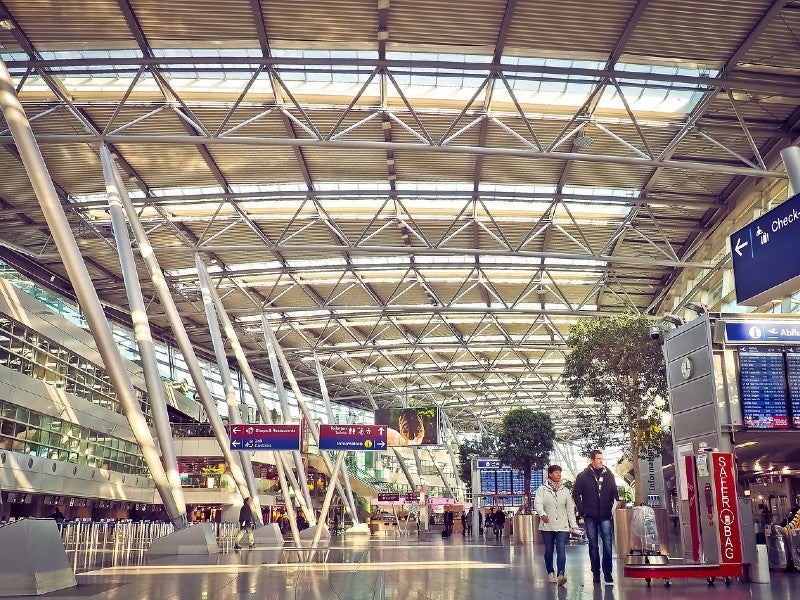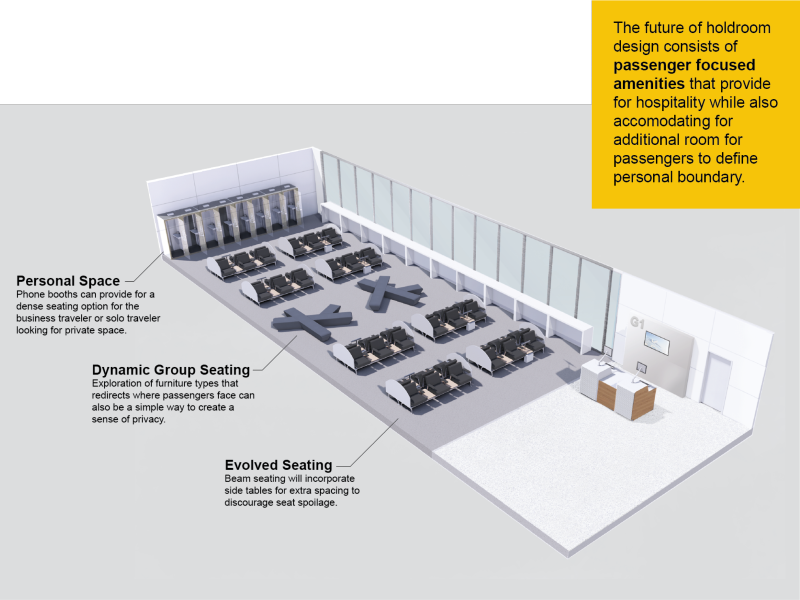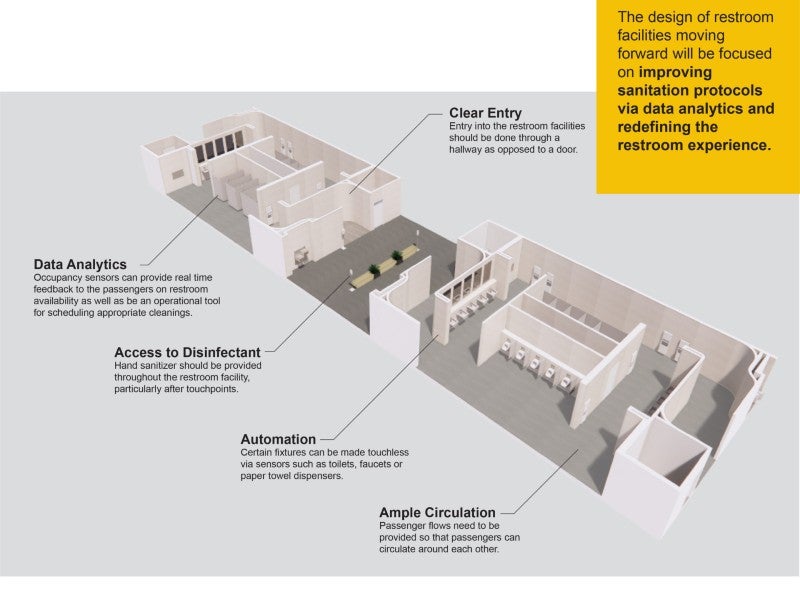
Covid-19 brought the travel industry to a standstill. Borders were shut and flights were drastically reduced as countries acted to limit the spread of the virus. Countries are now beginning to consider reopening to foreign visitors, but for the air industry, it is likely to be a long, turbulent route back. The airport environment will need to undergo drastic changes to limit the spread of germs and help passengers to feel safe. Through its Airports Adapt series, architecture and design firm Corgan has been exploring how airport design can be altered to help the aviation industry adjust to this new reality.
We spoke to Scott Gorenc, studio design director for Corgan’s aviation studio, to discuss the impact Covid-19 is likely to have on traveller expectations and how this will alter the way airports are designed.
Airport design to encourage social distancing
Over the past few months, healthcare experts have repeatedly warned people to avoid crowded spaces and maintain up to 2m of space between each other. Social distancing measures will eventually be relaxed. However, Gorenc anticipates a “new definition for personal boundary” that will force airports to adapt.
“[Airport design] will be more about the efficient use of the space available on both the airside and landside of terminal facilities, so that we can improve the usage of high-density areas such as holdrooms and concessions seating,” Gorenc explains.
To reduce occupancy in these areas, airports must find ways to attract passengers to atypical terminal spaces. Corgan believes that this can be achieved by offering unique amenities that encourage passengers to venture away from gates and holdrooms. The 114,000l aquarium at Vancouver Airport offers a grand example of this. However, Gorenc believes that simpler additions, such as lounge seating or experiential pop-up retail, could also help to improve the distribution of passengers.

How well do you really know your competitors?
Access the most comprehensive Company Profiles on the market, powered by GlobalData. Save hours of research. Gain competitive edge.

Thank you!
Your download email will arrive shortly
Not ready to buy yet? Download a free sample
We are confident about the unique quality of our Company Profiles. However, we want you to make the most beneficial decision for your business, so we offer a free sample that you can download by submitting the below form
By GlobalDataHowever, in some cases, encouraging social distancing will prove more challenging. Crowded departure gates, for example, will be hard to avoid. Corgan believes making changes – both temporarily and permanently – to seating would help to reduce any risk.
Adaptive components could be used to block off seats while simultaneously creating new spaces to place luggage, and in turn, freeing up more floor space. However, providing a variety of seating options could offer a more long-term solution.
Personal, phone booth-like areas would offer a safe space for solo travellers, for example. Likewise, dynamic seating, designed to ensure passengers face away from each other, could be used to accommodate larger groups.
Emerging technology to create touchless processing
Covid-19 has served as a catalyst for contactless in many of our dense public spaces, and airports are likely to see similar changes. From having your passport handled during the check-in process, to passing through security, to making purchases inside the terminal, various touchpoints could potentially transmit germs between passengers and employees.
While processes such as check-in queues or pat-down procedures may seem unavoidable, emerging technologies are providing new solutions that can help to make airport processing procedures touchless, safer and more fluid.
“To achieve a touchless processing experience, there will be many hurdles to overcome,” Gorenc insists. “Technologies such as biometrics, automation and blockchain will play a key role in overcoming this.”
Automation technology can provide quicker processing without impacting security. Evolv Technology’s Edge detection system, which is already providing additional security at Oakland International, can screen up to 800 people per hour.
The system can detect metallic and non-metallic items of interest without requiring passengers to empty their pockets or remove items such as laptops. Such systems could significantly speed up the process, and subsequently reduce queues during check-in and security.
Automation offers yet more potential in the form of automated baggage handling and inspections, while biometrics would speed up the process further by reducing the need for manual identity checks. To address concerns about the privacy and security of biometrics, blockchain could help to maintain and protect such data.
Envisioning a tech-driven airport departure experience
Corgan’s vision for a touchless departure experience envisions guests checking in via a mobile device and drop off luggage at a self-service bag drop. Landside, facial recognition technology will scan passengers to determine whether they are travellers or well-wishers. Artificial intelligence will scan crowds for suspicious behaviour and flag passengers for additional screening.
Airside, restrooms will be fully automated using sensors, removing the need to touch door handles, taps, and fixtures. Customers will complete transactions using tokenised mobile payment methods, and mobile ordering will provide food delivery throughout the terminal.
Mobile notifications will alert passengers once it is time to head to the departure gate. There, a series of biometric checks will be carried out, as well as behavioural analysis and 3D imaging to ensure passengers are safe to board.
Alleviating passenger fears
According to a report published by marketing agency Mower, just 16% of US adults would be willing to travel immediately after restrictions are lifted. Just under half would still be unwilling to travel two months later.
“Aside from the physical modifications to the build environment, we really need to tap into travellers’ psychological comfort,” Gorenc says. “For the majority, travel by air is a choice, not a necessity, and we will have to go above and beyond to gain passengers’ trust so they feel safe to fly again.”
Industry organisations such as the International Air Transport Association have already issued various guidelines and recommendations for the aviation industry to implement in the wake of coronavirus, such an increasing the frequency and extent of cleaning operations.
While no significant changes would be required for this to occur, Corgan believes that redesigning the layout, circulation, fit and finish of airports would ‘lay the foundation’ for providing a clean and sanitary environment.

Corgan offers solutions such as occupancy sensors to monitor the use of an area and improve cleaning schedules, widening entryways, and providing access to disinfectant around touchpoints. Gorenc believes that giving passengers “ownership” of how this experience evolves through the use of feedback loops that allow passengers to provide feedback to cleaning staff would help to further reassure passengers.
“By calming anxiety and assuaging fear, it would streamline and drive commerce in the terminal, but perhaps most importantly, it would allow the passenger journey to return to what it was at the beginning, which was an adventure, not a burden,” Gorenc says.
Does Covid-19 represent an opportunity for positive change for airport design?
Covid-19 will force the aviation industry to adapt. However, these changes won’t just help to address new issues created by the coronavirus, but also pain points that have existed in the aviation passenger experience for some time. There are likely to be few complaints about improved hygiene, fewer queues, and less intrusive check-in and security processes.
“Not only are many of the solutions beneficial as a response to the Covid-19 pandemic, but they align with the aspirations of the modern traveller,” Gorenc explains. “A tailored experience that maximises the user experience for both passengers and employees elevates the airport beyond the expectations of today into a contemporary experience for tomorrow.”



